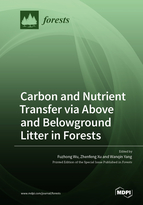Carbon and Nutrient Transfer via Above and Belowground Litter in Forests
A special issue of Forests (ISSN 1999-4907). This special issue belongs to the section "Forest Soil".
Deadline for manuscript submissions: closed (20 June 2022) | Viewed by 26702
Special Issue Editors
Interests: forest litter; soil organic matter; nutrient cycling; soil humus; litter humification
Interests: root litter; carbon and nutrient cycling; alpine/subalpine forests; litter decomposition
Special Issues, Collections and Topics in MDPI journals
Interests: woody debris; soil organic matter; nutrient cycling; soil carbon sequestration; forest litterfall
Special Issues, Collections and Topics in MDPI journals
Special Issue Information
Dear Colleagues,
Plants periodically shed more than 90% of their biomass production as above- and below- ground litter, including foliar, twig, flower, log, root and others. It is one of the key biogeochemical processes in transferring carbon and nutrients from plants back into the soil within forests, which are the most important sources of soil organic matter formation and are crucial in maintaining soil fertility. Furthermore, how to sequester more carbon in forest soil by litter production and humification could currently be a potential efficient strategy serving “carbon-neutral”and sustainable forest management.
It is well documented that global lands have been greening since the 1980s. As a result, plant litter production inevitably increases with increasing net primary productivity. However, current attention has not been fully paid to the changes of litter quality and quantity, and the transfer processes of carbon and nutrients through litter production or decomposition in forests. Moreover, these processes may respond differently to the ongoing climate change among forest ecosystems. Obviously, up-to-date knowledge and theory are urgently needed.
We are seeking papers on the questions above. This Special Issue will provide an opportunity to present the results of studies on the past, current and future carbon and nutrient transfer from forest litter.
Prof. Dr. Fuzhong Wu
Prof. Dr. Zhenfeng Xu
Prof. Dr. Wanqin Yang
Guest Editors
Manuscript Submission Information
Manuscripts should be submitted online at www.mdpi.com by registering and logging in to this website. Once you are registered, click here to go to the submission form. Manuscripts can be submitted until the deadline. All submissions that pass pre-check are peer-reviewed. Accepted papers will be published continuously in the journal (as soon as accepted) and will be listed together on the special issue website. Research articles, review articles as well as short communications are invited. For planned papers, a title and short abstract (about 100 words) can be sent to the Editorial Office for announcement on this website.
Submitted manuscripts should not have been published previously, nor be under consideration for publication elsewhere (except conference proceedings papers). All manuscripts are thoroughly refereed through a single-blind peer-review process. A guide for authors and other relevant information for submission of manuscripts is available on the Instructions for Authors page. Forests is an international peer-reviewed open access monthly journal published by MDPI.
Please visit the Instructions for Authors page before submitting a manuscript. The Article Processing Charge (APC) for publication in this open access journal is 2600 CHF (Swiss Francs). Submitted papers should be well formatted and use good English. Authors may use MDPI's English editing service prior to publication or during author revisions.
Keywords
- forest litterfall
- carbon sequestration
- nutrient cycling
- litter decomposition
- litter humification
- soil organic matter






